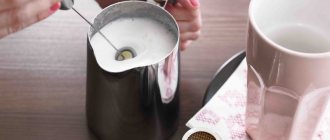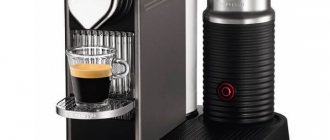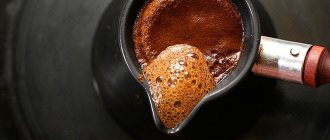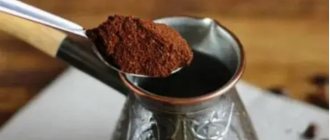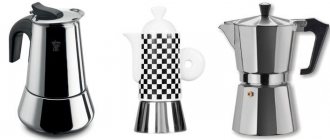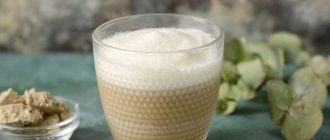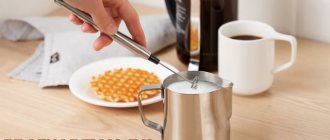Many of us love coffee very much, starting every morning with a cup of hot, aromatic cappuccino. It is considered the second most popular after espresso. Cappuccino is prepared in a special way based on espresso and milk. Some rightly suggest that there is no better coffee than a properly prepared cappuccino.
This aromatic, airy drink was invented in Italy. One day, a coffee-loving monk decided to add milk to it. He quickly poured the liquid into the coffee, after which a light foam formed, pleasant to the taste. Then the idea of whipping preheated milk or cream appeared.
General idea of cappuccino
Cappuccino was invented hundreds of years ago by Italian Capuchin monks. The drink consisted of coffee and milk with high fat content, at that time goat milk was used for preparation. Today there are many recipes known that make it possible to obtain such coffee; an integral component of each of them is milk whipped to a thick foam.
The classic cappuccino recipe involves strong espresso, frothed milk and thick milk foam.
Also, other ingredients are added to the drink that significantly affect its taste: chocolate, all kinds of syrups, etc. As a rule, the composition of cappuccino varies depending on the location of preparation. At first, the drink was whipped by hand, and then a special device (cappuccino maker) was invented, consisting of two containers: for milk and water. The steam generated by heating the water flowed through a tube into a container with milk, whipping the product into a thick foam. Modern coffee machines whip up steam on their own.
Rating of inexpensive brands of milk for cappuccino
Of course, milk specifically for cappuccino is more expensive than usual. But you can find good milk for cappuccino in a very budget price segment.
Milk River
This is premium quality milk, ultra-pasteurized. It contains ideal proportions of fat ( 3.5% ) and protein ( 2.8 grams). This gives, firstly, a good thick foam that does not settle for a long time. Secondly, a pleasant creamy-sweet taste.
Average price: 82-84 rubles.
Parlamat
Also premium quality milk. It whips up perfectly in a coffee machine and by hand, forming a thick, dense foam. And it lasts a long time even with a hot drink. In addition, after heat treatment, milk retains all useful substances, vitamins and microelements.
The fat content in it is 3.5% , protein is approximately 2.8-3 grams.
The advantage of this product in the packaging: it has a convenient lid.
Average price: 80 rubles.
Good Burenka
This is ultra-pasteurized milk, which is perfect for cappuccino. It does not contain preservatives. The foam from it whips up easily and has a pleasant sweetish tint.
It contains about 3.5% fat and 3 grams of protein.
The average cost is 73 rubles.
Milk fat content value
The level of fat content determines not only the taste of the drink, but also its consistency. The optimal indicator for making cappuccino is 3–4%. This milk can be called the golden mean: it is not watery, but not too fatty, which makes it possible to achieve the ideal combination of taste and density of coffee. It also produces a signature foam: sweetish-creamy and thick, for which cappuccino is valued.
A drink made from milk with a low fat content (1–2%) does not differ much in taste from its counterpart with a fat content of 3.5%. However, this coffee seems too liquid. Sometimes the barista mixes milk (3.5%) with skim milk. This decision is absolutely wrong, and the difference is clearly visible.
When using milk with low fat content, a dry and fairly dense foam is obtained, which gives the coffee a gray tint, but does not make its consistency thicker.
You can get a fragrant and rich cappuccino only with the addition of milk of 3–3.5% fat.
The best non-specialty brands
If it is not possible to purchase special milk, you can use analogues, which are also used for regular drinking. In terms of taste, this product is no different, it is whipped in the same way, the foam has all the necessary parameters.
According to experts, the following types of milk are ideal for home use of coffee machines:
Prostokvashino “Otbornoe” 4.5% fat
In addition to its high butterfat content, milk is packed with nutrients.
Village Zelenoe 3.2% fat
It whips up easily, has a pleasant taste and a fairly thick consistency.
Valio 3.2% fat
High quality, natural taste, but slightly overpriced.
It is not recommended to use whole cow's milk even after boiling it. It is impossible to track its fat content, which does not provide guarantees regarding the quality of whipping and the foam formed.
Lactose and protein content
The amount of protein contained in the drink affects the quality characteristics of the foam:
- gives stability that allows it not to settle for a long time;
- makes the creamy taste more pronounced;
- imparts elasticity.
For you:
What you need to brew delicious coffee with foam in a Turk, recipes
This effect can be achieved provided that milk containing at least 3 g of protein is used to prepare cappuccino.
For cappuccino, only natural products are chosen, excluding the presence of various powders.
The classic sweet taste of the foam is provided by milk sugar (lactose). When heated, it splits into two components: galactose and glucose. It is possible to get a “cap” with a rich taste only if the carbohydrate content is not lower than 4 g. Due to lactose intolerance by some people, good coffee shops prepare lactose-free cappuccino with a top that is not inferior in taste to the classic version.
Which milk is better to choose?
Regardless of which frother is used, the desired result can only be achieved by choosing the right dairy product. Attention should be paid to fat content and protein content.
Fat content
This indicator is extremely important to take into account. The texture and taste directly depend on it. For example, if the fat content of a product varies between 0.5-2%, it will be quite easy to work with. The foam will be fluffy, but watery. When using dairy products with indicators of more than 3.5%, a slightly different problem is observed. The foam is soft and tasty, but it is difficult to whip up.
Experienced baristas say that the best milk for cappuccino is 3.2% fat . When using it, the drink will have an excellent taste, and the foam will be dense and fluffy.
Protein content
This indicator is rarely paid attention to. At the same time, it is of no small importance. If the protein content is less than 2%, the cappuccino foam will not perform as expected. It is recommended to choose products with an indicator of more than 3%. When using it, the result will certainly please you.
Suitable milk temperature
The rules for preparing high-quality cappuccino require the use of milk at a temperature of +4 °C. In addition, the product should not be boiled before beating. In the process of obtaining foam, it is important not to exceed the temperature, varying in the range: +67… +75 °C. Otherwise, protein compounds will be destroyed, the drink will acquire an unpleasant odor and bitter taste, and the foam will not meet the stated characteristics.
Milk is whipped only in a dry pitcher, since contact of this product with moisture significantly impairs the frothing process.
How to froth milk for coffee
Proper milk foam for cappuccino should be as homogeneous and elastic as possible; large bubbles are unacceptable. It’s easy to check whether it corresponds to the ideal: you need to scoop up a little foam with a spoon and pour it onto a saucer. If the foam is so dense that it flows slowly, it is suitable for cappuccino. Too thin foam is only suitable for lattes.
Steam cappuccino makers (steamers)
The ideal milk foam in cafes is obtained using cappuccino makers built into coffee machines. Carob coffee makers are often equipped with cappuccino makers.
Steam cappuccino makers in coffee machines (steamers) are of two types:
- automatic;
- mechanical.
When an automatic cappuccino maker operates, milk is sucked through a tube into the cappuccino maker’s container, where it is whipped with steam.
A mechanical steamer is a steam tube with a special nozzle (panarello), with which you can quickly and efficiently whip milk into foam for coffee. Before frothing, milk must be cooled to at least +10 °C. It is also better to put the pitcher in the refrigerator first.
Recipe for frothing milk with a mechanical steamer
- Pour milk into the pitcher (special jug). Due to the foam, the volume of milk increases approximately 2 times. Therefore, the level of milk in the pitcher should not be higher than the base of the spout (groove), otherwise the foam will splash out.
- Turn on the cappuccino maker and wait until steam with drops of water comes out and the steam becomes “dry”.
- Lower the steamer nozzle into the milk approximately 0.5–0.7 cm. The tube should be located away from the center of the pitcher, but not at the very edge. The pitcher should be tilted slightly away from you: then when turned on, the liquid will begin to move in a circle.
- Turn on the pitcher. If the sound is too dull, it means the nozzle is too deep in the liquid. If the sound is whistling, the nozzle is too high. If splashes appear when whipping, the nozzle needs to be lowered a little.
- When whipped, the volume of milk increases greatly. As the foam rises, the pitcher is lowered so that the nozzle is constantly at the very boundary between the milk and air, but is completely immersed in the milk.
- When there is enough foam, the pitcher is raised so that the nozzle does not reach the bottom by about 0.5–1 cm. You need to hold the pitcher by the handle with one hand, and support the bottom with the palm of the other. When the bottom warms up so much that your hand becomes too hot (that is, to a temperature of +55 to +65 ° C), stop beating.
- The foam does not always immediately turn out homogeneous. To compact it and get rid of large bubbles, the pitcher is placed on the table and, without lifting the bottom from the tabletop, quickly make 10-15 circular movements. Then lightly shake the pitcher several times (5-6), knocking the bottom on the tabletop.
Manual cappuccino maker
There are small hand-held, battery-powered cappuccino makers on sale. Unlike steamers, manual frothers do not heat the milk. To keep the foam tender, it should be heated before whipping. Coffee lovers who love precision measure the milk temperature with a thermometer: it should not be higher than +65 °C. But you can just watch the milk: at this temperature, steam begins to form.
Manual cappuccino maker
Having noticed steam, remove the bowl with milk from the heat, lower the cappuccino maker whisk into it, slightly tilting it, and begin to whisk. When the milk froths, the foam must be compacted in the same way as when whipping with a steamer.
Mixer and blender
You can use a mixer or blender to froth warm milk. Sometimes, to save time, it is whipped while heating. In such cases, place the container with milk on a small fire and immerse the device nozzle in it. Remove the frothed milk from the heat and thicken the foam by shaking the container.
Mixer
French press
Warm milk is poured into a French press and whisked vigorously with a piston. In about a minute the foam will be ready, all that remains is to compact it.
French press
Hand whisk
Warm milk can be beaten with a regular egg whisk. True, the foam will be less dense and stable than even when foaming in a French press.
Hand whisk
Frothing milk in a jar
When not only household appliances, but even a whisk are not at hand, an ordinary jar with a lid will help out. Fill the container no more than halfway with warm milk, close the lid and begin to shake vigorously. The foaming process lasts 0.5–1 minute.
You can do it differently: before frothing milk for coffee, do not heat it. You need to froth cool milk in a jar and then put it in the microwave for about 30 seconds. When heated in the microwave, the foam thickens a little.
Characteristics of the right foam
The following signs indicate the quality of cappuccino foam:
- Uniform consistency, presence of bubbles. High-quality foam flows slowly from the spoon, and its height is maintained for a long time.
- The presence of a pronounced ice cream flavor , which can be achieved only from milk with the required fat content.
- Stickiness , which gives the drink a subtle taste and depends on the amount of protein contained in the product.
Also, the quality of foam is determined by such indicators as:
- chilled – colder milk whips faster and produces a stable foam;
- functionality of the device used for whipping; Over time, they become clogged and lose their original effectiveness.
Key selection parameters: what you should pay special attention to
Where do you use the coffee machine?
In catering at home
Experienced baristas who make coffee every day and know everything about this process say that when choosing milk you need to take into account the following nuances:
- Fat content - the higher the concentration of milk fats in the product, the richer the creamy taste will be. For cappuccino with stable foam, milk with a fat content of 2.5-3% is suitable. For lattes and latte macchiato, 1.5-2% is enough. The fattier the milk, the faster it whips and the longer the foam lasts.
- Degree of naturalness – when using milk in a coffee machine, fresh whole and fresh milk is not suitable. It is best to use pasteurized and ultra-pasteurized as it is easier to whip and easier to store.
- Packaging features : tetrapacks with a lid are convenient. Milk is added to the machine as it is consumed, and the bulk of it is stored in the refrigerator.
- The percentage of protein content - this indicator determines the characteristics of the foam itself. A soft creamy taste, stable foam that does not settle and stretches pleasantly while drinking coffee is achieved through milk with a protein content of at least 3 g.
- Date of manufacture - milk, the expiration date of which is a week is not suitable. We need ultra-pasteurized varieties that can be stored at room temperature without losing their properties.
In addition, the quality of milk foam depends on such parameters as:
- Degree of cooling - the colder it is, the faster the foam whips and the more stable it is.
- Features of the coffee machine - some cappuccino makers become clogged over time and work worse.
Expert opinion
Borodina Galina Valerievna
Coffee experts do not recommend using regular packaged milk, but giving preference to a product marked “For cappuccino”, “For whipping”, “For coffee machines”. These options have a thicker structure and allow you to get the perfect foam.
Tips for choosing milk
When choosing, it is worth remembering that whole or natural fresh milk is not suitable for coffee machines, since their use significantly slows down the whipping process. Cappuccino is prepared from a pasteurized or ultra-pasteurized product, since it whips easily and allows long-term storage at room temperature without losing its original qualities.
It is best to give preference to milk with a special mark on the packaging - for example, “for cappuccino”, “for coffee machines” or “for whipping”. Using these options guarantees high quality foam.
Correctly selected products are simultaneously suitable for all types of devices: cappuccino maker, frother and paranello.
Main indicators of milk for frothing
Creating milk froth is a delicate art. To get it, you need to know the basic rules and gain practical experience. Whipped foam does not guarantee a pleasant taste of cappuccino, because a number of other parameters must be taken into account when preparing the drink. You can use automatic or manual cappuccino makers and coffee machines. The correct product will be prepared in any of these ways.
Indicators of milk for high-quality frothing:
- fat content;
- heat treatment method;
- protein percentage;
- liquid temperature.
This knowledge will help you choose the best manufacturer to create a delicate coffee drink. Its foam will be fine-celled, glossy, creamy and viscous.
Fat content
Fat content is one of the main parameters that must be taken into account. Each manufacturer produces drinks of different parameters. You can purchase low-fat products. When you whip it, you will also get foam. However, it will be loose and with a loose structure. When added to coffee, the bubbles quickly burst and the appearance of the drink deteriorates. Additionally, the taste will feel watery and rough.
To make the best cappuccino, an experienced barista chooses milk with a fat content of 3-3.5%.
When whipped, you get a dense, stable foam that has a creamy vanilla flavor. It does not lose its shape and structure when poured into a cup of coffee; it can be used for art decor.
Proteins and carbohydrates
Protein in flour is important when making baked goods, and in milk it also needs to be taken into account. It allows you to achieve a fairly dense foam texture, which, when poured, creates a feeling of viscousness, as if it were a butter cream. For cappuccino, milk must contain at least 3% protein.
The presence of carbohydrates in the liquid gives the drink a slight sweet taste. In milk, lactose is responsible for this, the content of which should be more than 4 g. Sometimes allergic intolerance or a disease such as celiac disease occurs. In this case, you need to choose a lactose-free alternative.
Milk processing methods
There are different ways of heat treatment of milk. Each of them has a different effect on the quality of the foam obtained when whipping.
During pasteurization, the liquid is heated once for 3-5 seconds to a temperature of +95ºС. The shelf life of such products is no more than 5 days.
During ultra-pasteurization, heating occurs to +140ºС. After this, the liquid is poured into sealed cardboard packages. This allows milk to be stored at room temperature for up to 2 months.
Sterilization is the best way to process liquids, in which 30 minutes of boiling kills all pathogenic microorganisms. It can be stored for many months at room temperature. This milk froths well, but must be cooled before use.
Review of the best brands
Regardless of which device will be used to prepare cappuccino, it is important to choose milk that meets all the criteria. Professional baristas have identified several brands of this product, which, in their opinion, are considered the best for preparation:
- Rioba (3.5%, UHT). This brand's milk is prepared from normalized cow's milk and is considered an ideal option for making cappuccino coffee. The product whips well, does not require boiling, has a sweetish taste and forms a dense, stable foam.
- “Petmol” (3.2%, UHT). Made from natural ingredients, it has a natural taste. Milk of this brand allows you to achieve high-quality foam with a rich taste, even with a hand blender.
- “House in the Village” (3.2%, UHT, for cappuccino). The product has a bright taste and does not contain additives or preservatives. Thanks to the high protein content, the foam is thick and airy.
- “Molochnaya Rechka” (3.5%, UHT, for cappuccino). Made from natural milk, it whips easily into a dense, airy, stable foam with the taste of ice cream.
- “Prostokvashino” (3.5–4.5%, pasteurized or selected). It is characterized by high taste and quickly whips to the required consistency.
For you:
How to make coffee with saffron and is it worth it?
The best brands of milk for cappuccino
It is preferable to take milk for the drink, the packaging of which says “for cappuccino”. Since it will have all the necessary characteristics.
The best brands of milk intended for cappuccino in a coffee machine and not only include Rioba, Valio, Molochnaya Rechka, Parmalat and others. The first brand is good because it was originally engaged in the production of coffee. That is, the specialists working there understand better than anyone which milk is best suited for cappuccino.
Valio is a good and high-quality manufacturer of dairy products. Experienced baristas say this is one of the best brands for making cappuccino at home.
Related material: How to make coffee with foam
Near the Molochnaya River you can find specialized milk for coffee. People who have tried the product say that it produces good foam and the taste of the drink itself is filled with pleasant creamy notes.
Features of using plant milk and cream
To make cappuccino, it is permissible to use a plant product made from coconut, soy, cereals, almonds, rice and nuts. However, when choosing them, it is important to consider a number of nuances:
- Milk of plant origin does not allow you to get foam with sufficient thickness.
- The nut, coconut and almond product is characterized by a high calorie content (up to 150 kcal per 100 g), therefore, when whipped, it forms a fluffy foam.
- The calorie content of milk made from cereals and soy is 50 kcal per 100 g, so the foam is less fluffy.
When using plant milk, coffee loses its creamy flavor and thick consistency.
Some baristas prefer to make cappuccino from cream: its rich taste gives the drink new shades. To get the right coffee, it is recommended to choose cream with a fat content of 10–15%. In this case, the foam will be uniform, smooth and with a pleasant texture. A product with a higher indicator, when whipped, forms lumps that are unpleasant in taste and unattractive in appearance.
Cappuccino is one of the most popular drinks prepared in bars, restaurants and at home. To obtain the appropriate quality, it is important to use milk with suitable characteristics.
Types of plant milk for cappuccino
There are various reasons for choosing plant-based milk: conscious veganism, lactose intolerance, concern for skin condition, etc. There are several types of plant milk:
- Soy. This is the most common type, and manufacturers have learned to make it so that it is suitable for making cappuccino. Its taste, of course, will be different from cow's, but foam is guaranteed. However, it is worth considering that soy milk curdles with acidic types of coffee. It also does not tolerate heat exceeding 60 degrees - it also collapses.
- Coconut. It is called coconut conditionally: the content of real coconut in it is 3-5% percent, the basis of such a drink is rice or soy milk. But this option is also not bad for coffee (but again for non-acidic varieties), it foams well. However, such milk will “drag” its taste to itself.
- Almond. It is more difficult to use: it is difficult to whip and the foam settles quickly, especially with very hot coffee. In addition, it can give the taste an unpleasant sourness.
- Oatmeal. An excellent option for coffee. It is not much different from cow's: it has approximately the same fat content, and some of the carbohydrates are broken down into glucose, which gives a pleasant sweet taste. It also foams beautifully and is suitable for a large number of coffee varieties. And even experts recommend using oat milk if for some reason cow’s milk is not suitable.
- Rice. This milk contains a lot of useful substances and, in principle, is not inferior to cow's milk. In addition, it is completely hypoallergenic. It also whips well when heated. The main thing is not to bring it to a boil and try not to exceed the temperature threshold of 60-70 degrees.
What is the difference between frothed milk for cappuccino and latte?
The main difference is the amount of dairy products. More than half of the latte composition is regular milk. A very small amount of foam is used. In the case of cappuccino, milk, foam and espresso are taken in equal proportions.
There is also a difference in density. For example, frothed milk in cappuccino is thicker. You can easily spread chocolate chips or cinnamon on the surface. The foam on the latte is not so dense. The powder does not stay on it.
One of the most important steps in making cappuccino is frothing the milk. You can prepare milk froth using either improvised means or special devices. To achieve the desired result, you need to follow the instructions and choose a dairy product responsibly.
How to properly prepare milk for frothing
In order to froth milk or cream in a coffee machine, you need to let it cool to a temperature of three to four degrees Celsius. The dishes must be dry during the procedure; it is better to wipe them before pouring milk into them. Watch carefully so as not to overheat the products during the beating process, this can lead to disastrous results.

